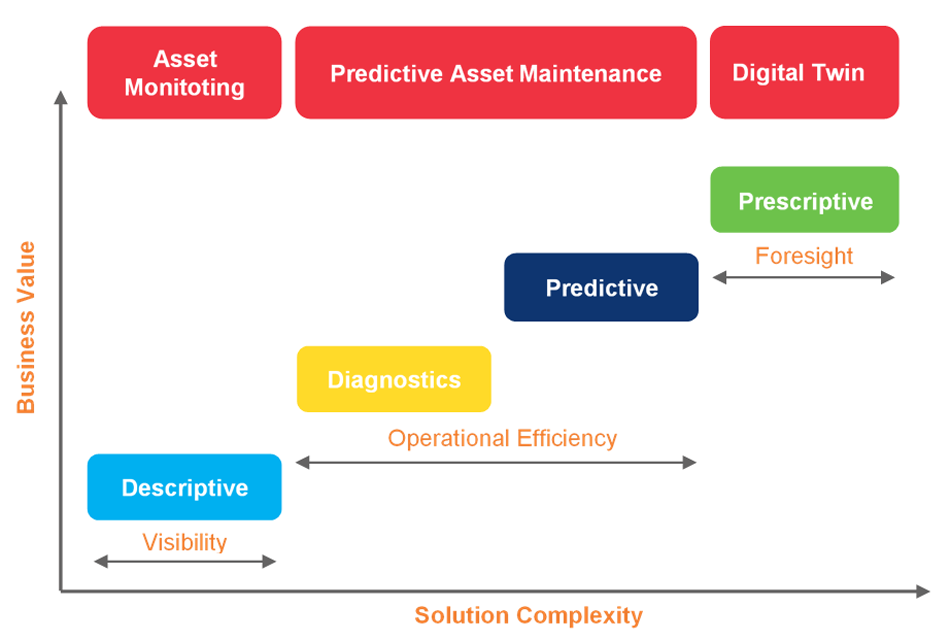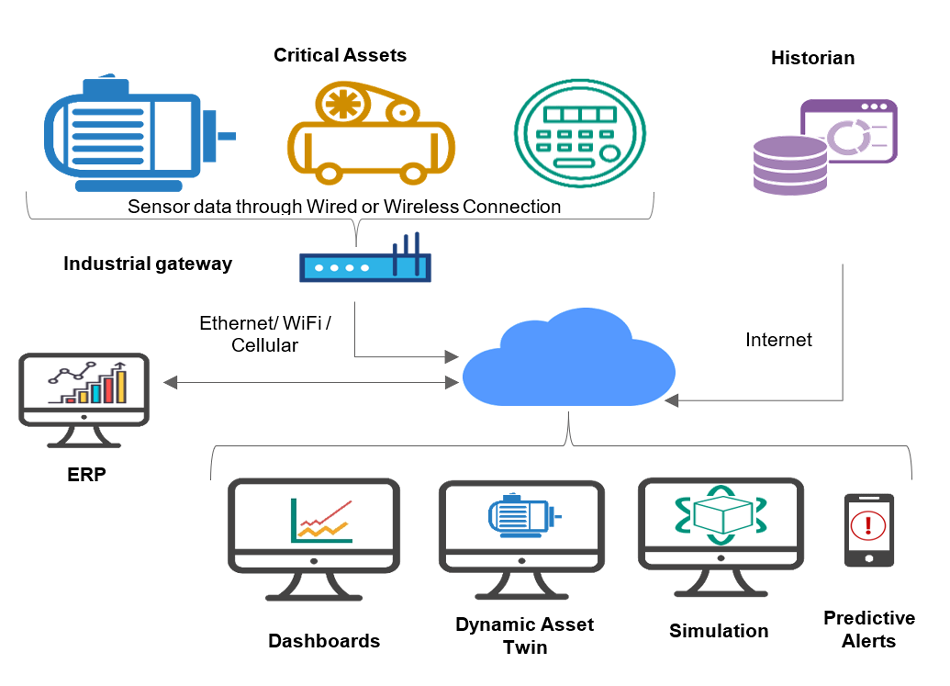Multiple industries such as Manufacturing, Healthcare, Energy & Utilities, Consumer, and Hi-Tech, nowadays are increasingly leveraging Internet of Things (IoT), connected devices and sensors to monitor the usage, health and efficiency of the assets remotely.
IoT is considered the driving force behind concepts like Industry 4.0, Smart Factories, Smart Devices and Connected Vehicles; enabling data collection, remote data transmission, automation, analytics and optimization of the processes. Every Industry has a set of assets amongst manufacturing equipment, machinery, motors, compressors, pumps etc. as part of their shop floor, production process or field operations. The data collected through IoT systems on the equipment status, operations and environment can not only be used to provide reactive inputs post data processing but also to deliver proactive insights for improving productivity, efficiency, and implementing predictive maintenance, thus ensuring reduced asset downtime.
Maturity levels in an asset based IoT solution
IoT and connected ecosystem drive digital transformation, allowing enterprises to monitor assets within facilities and remotely to improve operational efficiency through predictive and prescriptive solutions. A hierarchical 3 tiered approach (See Figure1) is recommended for dealing with assets and digital transformation in various industries in order to better manage them, reduce downtime and improve productivity.

Figure 1: Asset maturity and transformation journey
The proposed framework has various components in place to help in the digital transformation of the enterprise depending on the relevance, investment need and maturity level of the organization.
Asset Monitoring
Asset monitoring can provide better operational insights, increase asset utilization and higher productivity to industries leveraging asset visibility and traceability. The worldwide remote asset management market size is projected to grow from USD 16.5 billion in 2020 to USD 32.6 billion by 2025, at a compound annual growth rate (CAGR) of 14.6% during the forecast period1. The need for monitoring machine health and managing asset efficiency are the growth drivers in this space.
A model asset monitoring solution (See Figure 2) must comprise of a gateway, connectivity mode and a cloud application with dashboards to enable 24/7 asset visibility, ensure optimal asset utilization, provide better operational insights and help improve overall efficiency. The solution should be able to monitor parameters of the equipment like location, temperature, liquid level, operational hours etc. Connectivity is chosen based on the asset location, bandwidth requirements and desired reliability in communication.

Figure 2: Asset Monitoring Solution
Predictive Asset Maintenance
The next step in asset journey involves predicting and preventing any machine failure leveraging advanced IoT, cloud and machine learning technologies. The aim is to reduce operational costs by maintaining assets better, increasing their service life and overall plant effectiveness.
A model solution must collect different sensor data like vibration, acoustics, rpm, current, voltage from the machines through industry grade plug and play non-intrusive sensors and gateways; asset operational data from SCADA / PLC systems; historic data from OSI Pi and other related systems to analyze asset condition, operational parameters, environmental conditions, and production data in order to identify patterns, predict failures before they happen.

Figure 2: Predictive Asset Maintenance Solution
According to an estimate2, this market worldwide was valued at US$ 3.55 billion in 2019 and is projected to reach US$ 10.84 billion by 2027; it is expected to grow at a CAGR of 15.1% from 2019 to 2027. The growth driver for predictive maintenance solutions is the need to reduce maintenance cost and asset down time. Studies5 have shown that unplanned downtime is costing industrial manufacturers an estimated $50 billion each year. The report also suggests that manufacturers’ savings from predictive maintenance could globally total between $240 and $630bn by 2025.
Digital Twin
Digital Twin provides a virtual representation of assets using IoT, cloud, physics based simulations and advanced analytics. A model solution (See Figure 3) must deploy predictive and physics-based simulation models to provide diagnostics on off-design operation and performance assessment, detect anomalies, identify asset failure classifications, predict time to failure, and prescribe actions to prevent failures in advance.

Figure 3: Digital Twin
This helps in achieving improved efficiency and productivity, detecting problems in advance and resolving them faster with root cause identification, and providing baseline and drift analysis without need for physical experimentation of the asset in different conditions. Factory operators can derive multiple benefits such as:
According to an estimate3, the digital twin market is expected to grow at a CAGR of 38.1% from 2019 to 2025 to reach $30.1 billion by 2025. The key growth drivers are the need for identifying physical issues sooner and faster, predicting outcome for operational condition with higher degree of accuracy and increasing asset performance. According to a study6, 82 percent of participating companies had experienced unplanned downtime over the past three years. Analyst firm Aberdeen Research says that unplanned downtime can cost a company as much as $260,000 an hour. 44 percent have opined that a digital twin with predictive maintenance and artificial intelligence (AI) would help prevent major failures.
Conclusion
This article provides a tiered framework which can be easily adapted by industries to manage their equipment and factories to improve their operational efficiency and effectiveness (OEE) and reduce down time. Enterprises can apply this framework in a progressive manner to manage their assets, exercise better control and drive operational efficiency in their plants, factories, and remote stations.
References
SANTHOSH MADATHIL
Global Head of IOT Practice at Wipro, responsible for IOT Strategy, Consulting, IOT Offerings, IOT solutions for various Industry segments covering IOT Devices, Platforms, Edge, AI/ML, Analytics, Block chain etc. Prior to this, he was the Chief Technologist in the CTO Innovation Group of Wipro, where he was leading a team of researchers and technologists responsible for next generation technology areas of Connected, Intelligent Devices, Robotics, Drones and Internet of Things. Under his guidance the team has developed many innovative solutions addressing multiple Industry domains based on Connected, Intelligent devices, Computer vision, Robotics. He has 4 US patents granted in his name.